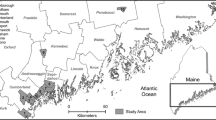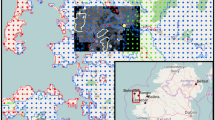Abstract
Energy-extraction results in significant disturbance to rangelands in Wyoming and other western US states. Although reclamation is required by law, US General Accounting Office reports from 1999 and 2005 are clear that affected government agencies have—over much of the past decade—had difficulty accomplishing mandated environmental monitoring of extraction-related disturbance. We evaluated two pipeline rights of way (ROW) using nested images (1- or 2- with 13- or 20-mm ground sample distance (GSD)) acquired during Very-Large Scale Aerial (VLSA) surveys. Aerial monitoring allowed for the collection of large numbers of geocoded samples, and for subsequent cover measurements using methods with demonstrated accuracy equal to that of conventional ground-based methods. Both pipelines had vegetative-cover deficiencies relative to their Plan of Development (POD) requirements. Using bare ground and ground-cover measurements from the higher-resolution imagery, we present a spatial representation of each pipeline ROW that allows quick identification of sections of the ROW that may need further reclamation action to meet POD standards. We also present aerial monitoring costs. We recommend VLSA pipeline surveys as a means for facilitating required environmental monitoring and for addressing the monitoring backlog that has developed with increased energy-extraction activity.
Similar content being viewed by others
References
Abel, N., & Stocking, M. (1987). A rapid method for assessing rates of soil erosion from rangeland: An example from Botswana. Journal of Range Management, 40, 460–466. doi:10.2307/3899612.
Alberta Environment (2004). Reclamation criteria for wellsites, batteries and associated facilities: Draft. Assessment protocol, (Vol. II) Retrieved from http://www.nicholsenvironmental.com/_doclibrary/upstream_criteria_vol_2_criteria.pdf.
Aldrich, R. C., Bailey, W. F., & Heller, R. C. (1959). Large scale 70 mm color photography techniques and equipment and their application to a forest sampling problem. Photogrammetric Engineering, 25, 747–754.
Bisson, H. (2007). Statement of Henri Bisson, Bureau of Land Management Committee on House Natural Resources Subcommittee on Energy and Mineral Resources and the Subcommittee on Parks, Forests and Public Lands Oversight hearing on Oil and Gas Impacts on Public Lands. BLM.
Booth, D. T. (1974). Photographic remote sensing techniques for erosion evaluations. M.S. Thesis, University of Nevada–Reno, Reno, NV.
Booth, D. T., & Cox, S. E. (2006). Very large scale aerial photography for rangeland monitoring. Geocarto, 21(3), 27–34. doi:10.1080/10106040608542390.
Booth, D. T., & Cox, S. E. (2008). Image-based monitoring to measure ecological change. Frontiers in Ecology and the Environment, 6, 185–190. doi:10.1890/070095.
Booth, D. T., Cox, S. E., & Berryman, R. D. (2006a). Precision measurements from very large scale aerial digital imagery using ImageMeasurement, Laserlog, and Merge software applications. Environmental Monitoring and Assessment, 112, 293–307. doi:10.1007/s10661-006-1070-0
Booth, D. T., Cox, S. E., & Berryman, R. D. (2006b). Point sampling digital imagery using ‘SamplePoint’. Environmental Monitoring and Assessment, 123, 97–108. doi:10.1007/s10661-005-9164-7
Booth, D. T., Cox, S. E., Fifield, C., Phillips, M., & Williamson, N. (2005b). Image analysis compared with other methods for measuring ground cover. Arid Land Research and Management, 19, 91–100. doi:10.1080/15324980590916486
Booth, D. T., Cox, S. E., & Johnson, D. E. (2005a). Detection-threshold calibration and other factors influencing digital measurements of bare ground. Rangeland Ecology and Management, 58, 598–604. doi:10.2111/05-060R1.1
Booth, D. T., Cox, S. E., & Simonds, G. E. (2006c). Riparian monitoring using 2-cm GSD aerial photography. Journal of Ecological Indicators, 7, 636–648. doi:10.1016/j.ecolind.2006.07.005
Bureau of Land Management (BLM) (US Department of the Interior). (2007). BLM oil and gas lease sale nets nearly $14.2 million, State of Wyoming to get half. News releases: June. Retrieved from http://www.blm.gov/wy/st/en/info/news_room/2007/06/06ogsale.html.
Cook, C. W., & Stubbendieck, J. (1986). Range research: Basic problems and techniques. Denver, CO: Society for Range Management.
FAA (Federal Aviation Administration). (2004). Airworthiness certification of aircraft and related products. Order 8130.2F.
General Accounting Office (GAO). (1999). Major management challenges and program risks: Department of Interior. GAO/OCG-99-9. Retrieved from http://www.gao.gov/pas/cg99009.pdf.
General Accounting Office (GAO). (2005). Oil and gas development: Increased permitting activity has lessened BLM’s ability to meet its environmental protection responsibilities. GAO-05-418. Retrieved from http://www.gao.gov/new.items/d05418.pdf.
Howell Petroleum Corporation. (2003). Plan of development. WYW148827 (p. 47). Casper, WY: Casper Field Office, Bureau of Land Management.
Interagency Technical Team (ITT). (1996). Sampling vegetation attributes, interagency technical reference, report no. BLM/RS/ST-96/002+1730 (p. 163). U.S. Department of the Interior, Bureau of Land Management, National Applied Resources Science Center, Denver, CO.
Lost Creek Gathering Company. (2000). Plan of development. WYW147148 (p. 41). Lander, WY: Lander Field Office, Bureau of Land Management.
Luscier, J. D., Thompson, W. L., Wilson, J. M., Gorham, B. E., & Dragut, L. D. (2006). Using digital photographs and object-based image analysis to estimate percent ground cover in vegetation plots. Frontiers in Ecology and the Environment, 4, 408–413. doi:10.1890/1540-9295(2006)4[408:UDPAOI]2.0.CO;2
Um, J. S., & Wright, R. (1998). A comparative evaluation of video remote sensing and field survey for revegetation monitoring of a pipeline route. The Science of the Total Environment, 215, 189–207. doi:10.1016/S0048-9697(97)00340-9
Vogel, W. G. (1987). Evaluating revegetation success. In W. G. Vogel (Ed.), A manual for training reclamation inspectors in the fundamentals of soils and revegetation (chapter 7, pp. 48–63). Washington, DC: U.S. Department of Agriculture, Forest Service and the Soil and Water Conservation Society.
Author information
Authors and Affiliations
Corresponding author
Rights and permissions
About this article
Cite this article
Booth, D.T., Cox, S.E. Dual-camera, high-resolution aerial assessment of pipeline revegetation. Environ Monit Assess 158, 23–33 (2009). https://doi.org/10.1007/s10661-008-0562-5
Received:
Accepted:
Published:
Issue Date:
DOI: https://doi.org/10.1007/s10661-008-0562-5




